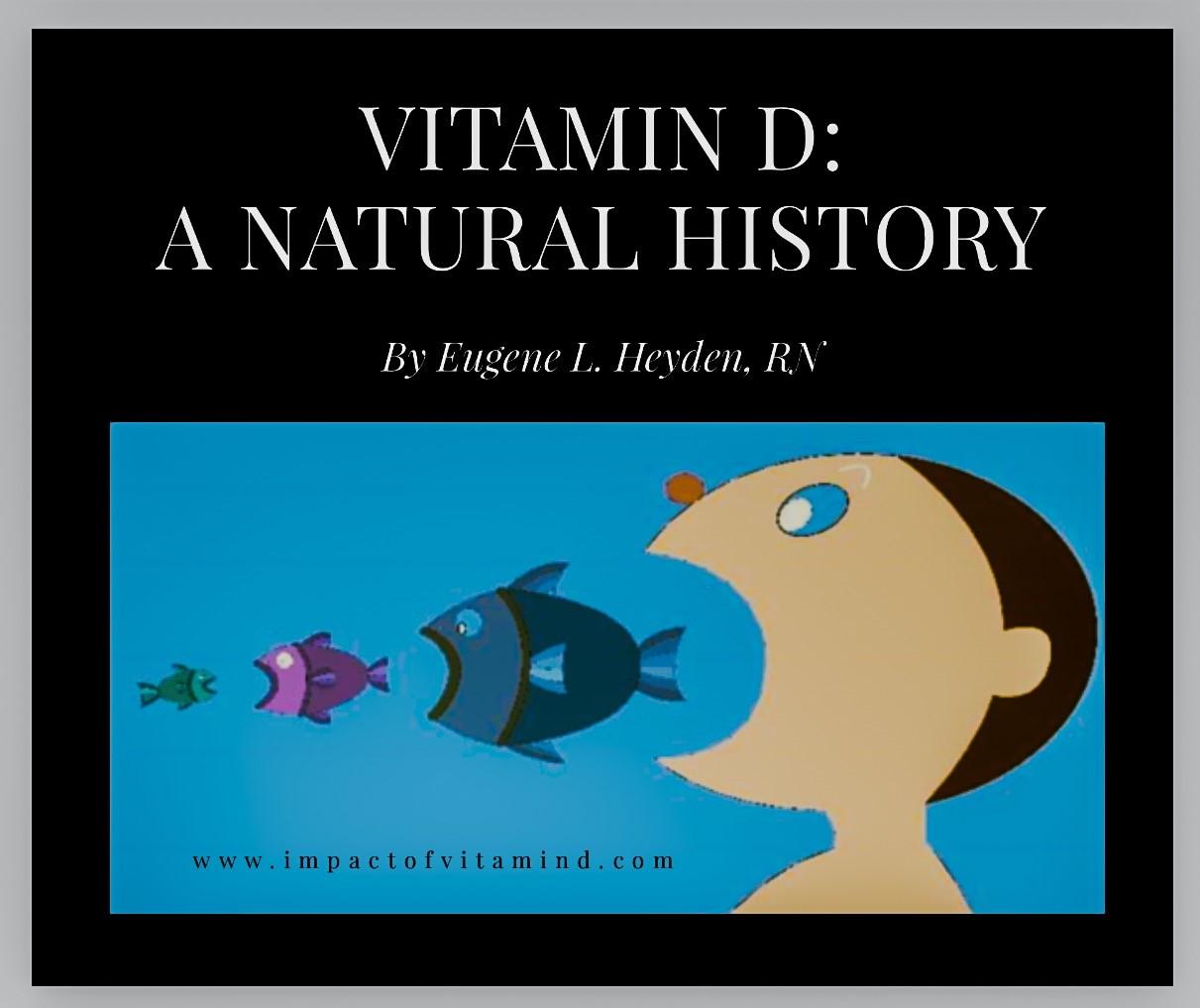Last update: 12-08-24
By Eugene L. Heyden, RN
“In terms of human history, humans were not confronted with vitamin D deficiency until the industrial revolution began.” ~Holick, 2003
“Despite evidence of its profound importance to human health, vitamin D inadequacy is not widely recognized as a problem by physicians and patients.” ~Holick, 2006
“Calling vitamin D a “vitamin” is something of a misnomer. Although the name is still used for historical reasons, vitamin D is more properly classified as a secosteroid [steroid hormone] because it consists of a cholesterol backbone and exerts steroid-like effects throughout the body, directly affecting the expression of over 1000 genes through the nuclear vitamin D receptor”. ~Cekic et al., 2011
Vitamin D has been around for a very long time and is perhaps the first true hormone in continuous use on planet earth. And it was free, freely derived from the sun. The single-celled creature created it for personal use in many of its metabolic activities. Then along came a hungry multi-celled creature that ate the single-celled creature. And in this manner, driven by the need of some creatures to eat other creatures in order to survive, vitamin D became a hormone that could be passed along from creature to creature within the food chain, a hormone useful to the metabolic processes of the one who had not yet been eaten.
Somewhere along the way, along came the hungry human. And, as luck would have it, the human saw a fish. And so the human ate the fish that ate other little fishes that ate the multi-celled creatures that ate the single-celled creatures, and in this manner the human was able to obtain an important ingredient, a hormone that somehow became necessary to sustain life. But the food chain was just one way to get this hormone. Nudity was another. So like many other creatures both big and small (and naked), humans were able to obtain vitamin D in abundance by exposure to the sun. Eventually, nudity gave way to clothing (thank God!), and still mankind was able to get plenty of vitamin D, both by diet and by sunlight exposure.
And so, for what seems like forever, the human race obtained plenty of vitamin D to meet its needs. Then came the Industrial Revolution, and boy, did we get into trouble. And then came the dermatologists with truckloads of sunscreen, and boy, did we get into even more trouble.
In this context of reduced exposure to sunlight and alterations in diet, humanity is now faced with a host of diseases that are related, in part, to a lack of vitamin D; related, in part, to an immune system that is compromised; related, in part, to a medical profession that just can’t seem to wrap its mind around this simple truth: Vitamin D must be in adequate supply or people will show up in droves to get drugs to treat diseases that are related, in part, to vitamin D deficiency. Multitudes will suffer. Many will die. All of this is so very true. This is why I wrote a certain little book on vitamin D.
How vitamin D became so essential to our musculoskeletal system, to our nervous system, to our immune system, even to the hair we grow on our head, is indeed somewhat of a mystery. Many a physician is still waiting for all the details to be worked out before venturing forth and paying very close attention to this vitamin, this hormone, the one we call vitamin D. Fortunately, things are beginning to change. But be aware, your physician may not be all that into vitamin D, in addition to all the other things he or she is not all that into. I am speaking in generalities, of course. Let’s hope that your physician is very knowledgeable in the issues that surround vitamin D and its relationship to the diseases that he or she sees each and every day. But you are clueless, probably, so I will need to get you up to speed.
Let’s start with the skin. The skin is really dead. It is the under-the-skin skin that is relevant to our discussion. Here we find living tissue containing all sorts of things, including a molecule that can either become cholesterol or become vitamin D, a molecule known as 7-dehydrocholesterol. Sunlight, specifically the UVB wavelength, has the capacity to deform 7-dehydrocholesterol, and a hormone is born. This newly formed molecule no longer “fits in” with its neighbors (it must look kinda different) so it is forcibly evicted and eventually finds its way to the liver where it is stored, processed, and sent forth as a prohormone to the kidney or to one of many other organs, tissues, and cells where it is converted by an enzyme called 1-alpha-hydroxylase into its active form. While in its active form, called calcitriol or 1,25(OH)2D3, vitamin D joins up with a nuclear receptor called the vitamin D receptor (VDR) and the magic happens. Up to 1000 genes or more can respond, orchestrating genetic events that promote health and resistance to disease.
So now you know the natural history of vitamin D. Please keep in mind that you, too, have a natural history, one that is currently in progress. This vitamin, this hormone, may help make the story of you a lengthy one and a relatively smooth ride.
Related post (Click image to open)
References:
Cekic M, Cutler SM, VanLandingham JW, Stein DG 2011 Vitamin D Deficiency Reduces the Benefits of Progesterone Treatment after Brain Injury in Aged Rats. Neurobiology of Aging 32:864–874
Holick MF 2003 Vitamin D: A Millenium Perspective. Journal of Cellular Biochemistry 88:296–307
Holick MF 2006 High Prevalence of Vitamin D Inadequacy and Implications for Health. Mayo Clin Proc; March; 81(3):353–373
Disclaimer: This article is presented solely for informational purposes. The information contained herein should be evaluated for accuracy and validity in the context of opposing data, new information, and the views and recommendations of a qualified healthcare professional, and not to be substituted for professional judgment and guidance or to provide reason to neglect or delay appropriate medical care. It is the reader and reader only who bears the responsibility for any actions that could be construed as being a response to the information contained herein. The statements and opinions expressed by the author have not been reviewed or approved by the FDA or by any other authoritative body, nor is the author endorsing any product or specific therapy. This article is offered to the reader to broaden his or her understanding of the issues discussed and to help identify options that may be suitable for the individual to pursue, on behalf of self or others, under approval and direction of a qualified physician. The author and publisher offer no guarantees of the accuracy or validity of the quotations incorporated into this article or the accuracy or validity of the information presented by the resources that are herein recommended.
Copyright © 2017–2022 Eugene L. Heyden, RN
All Rights Reserved

DISCLAIMER: The book excerpts and articles featured on this website are offered solely for informational purposes. The information contained therein should be evaluated for accuracy and validity in the context of opposing data, new information, and the views and recommendations of a qualified health care professional, and not to be substituted for professional judgment and guidance or to provide a reason to neglect or delay appropriate medical care for self or for others. It is the reader and reader only who bears the responsibility for any actions that could be construed as being a response to the information presented. The statements and opinions expressed by the author or authors of the information provided on this website have not been reviewed or approved by the FDA or by any other authoritative body, nor is the author endorsing any product or specific therapy mentioned. The book excerpts, articles, statements, and opinions are offered to the reader to broaden his or her understanding of the issues discussed and to help identify options that may be suitable for the individual to pursue, on behalf of self or others, under approval and direction of a qualified physician or medical team member. All questions of a medical nature which arise from the book excerpts and articles available on this website should be directed at qualified health care professional.











